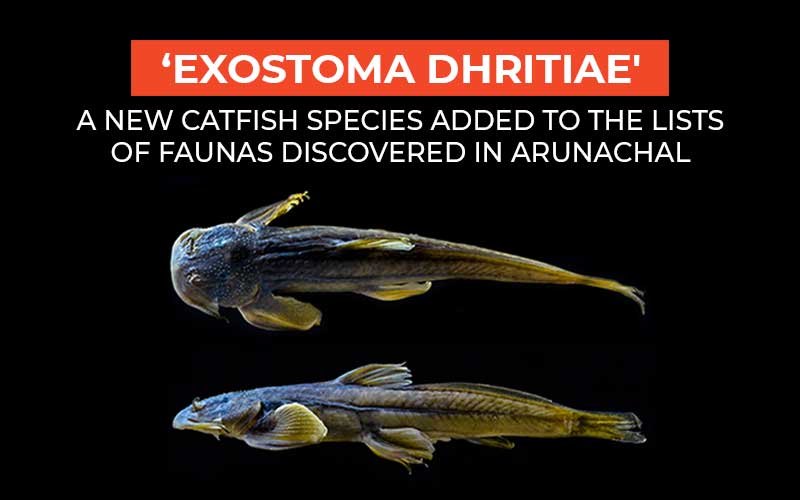
‘Exostoma Dhritiae' - A New Catfish Species Added to the Lists of Faunas Discovered in Arunachal
Recently, a new species of catfish has been discovered by scientists of the Zoological Survey of India (ZSI) from Siking stream in the Upper Siang district of Arunachal Pradesh. The new species has been named ‘ExostomaDhritiae’ after Dr.Dhriti Banerjee, the first woman director of the Zoological Survey of India (ZSI), Union Ministry of Environment & Forest and Climate Change to recognize her contributions to the study and understanding of the fauna of India. "ExostomaDhritiae," also termed locally as "Ngorang" in the Adi dialect, is a small freshwater fish known (currently) to exist in one location: the Siking stream, a tributary of the Siang River close to Yingkiong (Brahmaputra River drainage), Upper Siang District, Arunachal Pradesh. The Siking stream has a pebbly and cobbled bed and is shallow, chilly, and swift-moving. The native tribal people frequently catch catfish for their consumption.
The new species is described as a sisorid catfish of the genus Exostoma. The catfish genus Exostoma is distinguished by its homodont dentition, which includes distally flattened oar-shaped teeth on both jaws, bilaterally separated tooth patches in the upper jaw, a continuous post-labial groove, gill openings that do not extend to the ventral surface of the head, and 10–11 branched pectoral-fin rays. The Chao Phraya drainage in north-western Thailand and the Brahmaputra River drainage to the east are known drainages for the genus. Exostomadhritiae, collected from the Siking stream, Arunachal Pradesh has some affinities with other species of the genus reported from Bhutan, China, and India. However, the newly identified species can be distinguished from its family members by the condition of the posterior extremity of the adipose-fin base, the degree of tuberculation on the dorsal surface of the head, and the shape of striae on the anterolateral surface of the lips. Further, it is distinguished by the morphometric data for the body depth at the anus, maxillary barbel length, adipose fin base length, caudal peduncle length, caudal peduncle depth, and the number of branched pectoral-fin rays.
Whilst conducting an ichthyological study in the Siang River drainage near the Indo-China border, Dr.Pratima Singh, Dr. SD Gurumayum, and Dr. S. Rath collected some Exostoma specimens under the direction of Dr. L. Kosygin, Officer-in-Charge of the Freshwater Fish Department of ZSI, Kolkata. After closely examining the specimens in the Loratory, the researchers identified it as a new species and dubbed it Exostomadhritiae sp. nov. On December 8, 2022, Pratima Singh, L Kosygin, S D Gurumayum, and S Rath published the full details of their research in Zootaxa, a mega-journal in taxonomy published in New Zealand. For a detailed study, check https://www.mapress.com/zt/article/view/zootaxa.5219.2.5.
Until the discovery of this new hill stream fish in Arunachal, 19 species of Exostoma were known to be credible. It is the sixth species of Exostoma to be discovered in the Brahmaputra River basin in the northeastern Himalayas and the 20th overall. Arunachal Pradesh is one region that has recently drawn notice from researchers because of the new and extraordinary discoveries it has made in its wilderness. It is time to preserve our native plants and animals so that we can better understand nature and protect its habitat.
Disclaimer: The opinions expressed in this article are those of the author's. They do not purport to reflect the opinions or views of The Critical Script or its editor.

Newsletter!!!
Subscribe to our weekly Newsletter and stay tuned.

















Related Comments